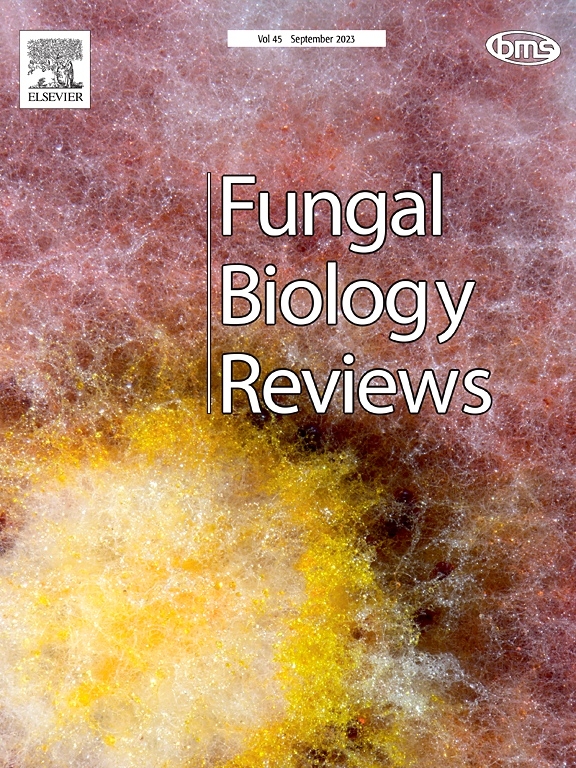CRISPR/Cas9: A cutting-edge tool for cellulase enhancement in fungi
IF 4.6
2区 生物学
Q1 MYCOLOGY
引用次数: 0
Abstract
CRISPR/Cas9 system is a cutting-edge gene-editing tool that has recently been introduced for the strain improvement of fungi to enhance their cellulolytic activity. Cellulase is an enzyme complex that hydrolyzes cellulosic fraction of lignocellulosic biomass into glucose which can be converted subsequently into biofuels and other value-added products. Among diverse microbial communities, fungi are considered the most potent cellulolytic candidates but the naturally low cellulase titers have been the major bottleneck in using them for industrial and biotechnological applications. However, CRISPR/Cas9 mediated fungal strain engineering has opened up new avenues to overcome this challenge by enabling precise and efficient genome editing which induces the overexpression of cellulase genes, deletion of cellulase repressors, and alterations in the regulatory elements governing the overall cellulase gene expression. The effective CRISPR/Cas9 systems have already been designed for the functional genome editing of industrially competent cellulolytic fungal strains such as Aspergillus strains, Trichoderma reesei, and Penicillium chrysogenum, however, the technological advancements to establish it across the fungal kingdom are still desired. The employment of CRISPR/Cas9 in fungal strain improvement poses various limitations such as off-target effects, the need for designing suitable delivery methods, and the appropriate selection markers, therefore, future research should focus on addressing these issues and further refining the CRISPR/Cas9 system for fungal strain improvement. Conclusively, this RNA-directed DNA endonuclease system is a promising future tool for improving cellulase production in fungi leading to the development of numerous industrially competent strains, thus, supporting the sustainable development goal (SDG 7) of affordable and clean energy through efficient bioconversion of lignocellulosic biomass into biofuels coupled with other value-added products.
CRISPR/Cas9:增强真菌纤维素酶的尖端工具
CRISPR/Cas9 系统是一种尖端的基因编辑工具,最近被用于真菌菌种改良,以提高其纤维素分解活性。纤维素酶是一种酶复合物,可将木质纤维素生物质中的纤维素部分水解为葡萄糖,然后转化为生物燃料和其他增值产品。在各种微生物群落中,真菌被认为是最有效的纤维素分解候选者,但天然的低纤维素酶滴度一直是将其用于工业和生物技术应用的主要瓶颈。然而,CRISPR/Cas9 介导的真菌菌株工程开辟了克服这一挑战的新途径,它可以进行精确、高效的基因组编辑,从而诱导纤维素酶基因的过度表达、纤维素酶抑制因子的缺失以及支配纤维素酶基因整体表达的调控元件的改变。目前已经设计出有效的 CRISPR/Cas9 系统,用于对具有工业能力的纤维素分解真菌菌株(如曲霉菌株、毛霉菌和青霉菌株)进行功能性基因组编辑。CRISPR/Cas9在真菌菌种改良中的应用存在各种限制,如脱靶效应、需要设计合适的传递方法和适当的选择标记,因此,未来的研究应重点解决这些问题,并进一步完善CRISPR/Cas9系统在真菌菌种改良中的应用。总之,这种 RNA 引导的 DNA 内切酶系统是未来改良真菌纤维素酶生产的一种很有前途的工具,它可以培育出大量具有工业能力的菌株,从而通过将木质纤维素生物质高效生物转化为生物燃料和其他增值产品,支持可持续发展目标(SDG 7)中的可负担得起的清洁能源。
本文章由计算机程序翻译,如有差异,请以英文原文为准。
求助全文
约1分钟内获得全文
求助全文
来源期刊

Fungal Biology Reviews
MYCOLOGY-
CiteScore
10.60
自引率
0.00%
发文量
36
期刊介绍:
Fungal Biology Reviews is an international reviews journal, owned by the British Mycological Society. Its objective is to provide a forum for high quality review articles within fungal biology. It covers all fields of fungal biology, whether fundamental or applied, including fungal diversity, ecology, evolution, physiology and ecophysiology, biochemistry, genetics and molecular biology, cell biology, interactions (symbiosis, pathogenesis etc), environmental aspects, biotechnology and taxonomy. It considers aspects of all organisms historically or recently recognized as fungi, including lichen-fungi, microsporidia, oomycetes, slime moulds, stramenopiles, and yeasts.
 求助内容:
求助内容: 应助结果提醒方式:
应助结果提醒方式:


